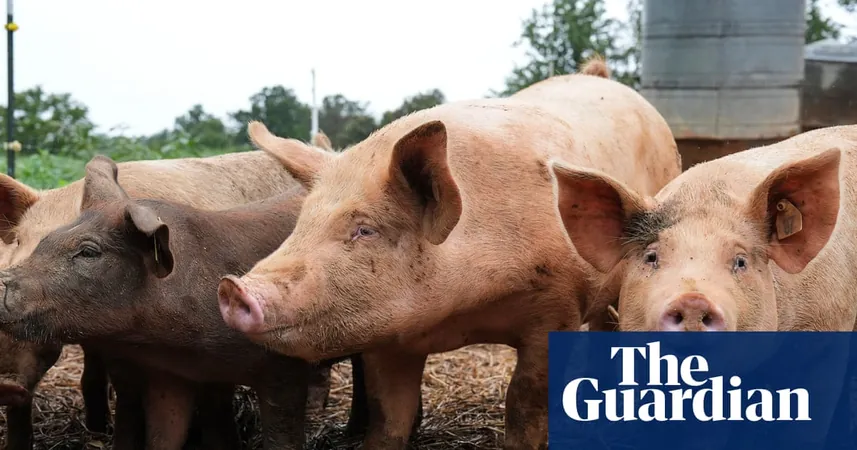
Groundbreaking Pig Lung Transplant in Brain-Dead Human: A Glimmer of Hope in Organ Donation Crisis!
2025-08-26
Author: Wai
A Historic First in Medical Transplants
In a dramatic leap forward for xenotransplantation, surgeons have successfully transplanted a genetically modified pig lung into a brain-dead human recipient. This pioneering procedure demonstrated lung function for an impressive nine days, marking a significant milestone in the quest to alleviate the global organ shortage.
The Organ Shortage Crisis
Currently, the World Health Organization estimates that a mere 10% of the global demand for organ transplants is being met. As transplant waiting lists grow longer, researchers are turning to innovative solutions like xenotransplantation—which involves using animal organs to address human needs.
Cautious Optimism from Medical Experts
Despite the encouraging results, medical experts urge caution. Dr. Justin Chan, a lung transplant surgeon at NYU Langone Transplant Institute, described the findings as "exciting and promising" but labeled the current success a "qualified success." He emphasized that these pig lungs are not yet capable of independently sustaining a human life.
Agreeing with Chan, Professor Andrew Fisher from Newcastle University noted that while this progress is valuable, it represents just a small step forward. "We are not on the cusp of an era of lung xenotransplantation just yet," he cautioned.
Xenotransplantation: Breaking New Ground
This groundbreaking research is part of a broader xenotransplantation trend, which has already seen animal organs like hearts, kidneys, and livers successfully transplanted into humans. Genetic modifications—removing certain pig genes and inserting human ones—help minimize rejection by the recipient's immune system.
The Challenges Ahead for Lung Transplants
However, lung xenotransplantation is particularly complex. Fisher explains that with every breath, lungs are exposed to environmental threats like pollution and infection, which require a highly responsive immune system. This presents unique challenges for organ transplants, where the goal is to suppress immune activity.
Details of the Historic Transplant
The transplant involved a left lung from a genetically modified Chinese Bama Xiang pig. Remarkably, the lung remained viable for 216 hours and did not trigger immediate rejection. However, by the 24-hour mark, signs of fluid buildup and initial damage appeared, likely due to transplant-related inflammation. Despite the recipient receiving strong immunosuppressive medications, ongoing immune responses eventually harmed the transplanted organ.
Looking Forward: Refining Techniques and Exploring Alternatives
The research team acknowledges the need for further refinements in their methods, including optimizing immunosuppression and improving genetic modifications. Professor Peter Friend, from the University of Oxford, emphasized that the acute inflammatory status of brain death complicates interpretations of the results.
Meanwhile, alternative avenues are being explored to increase organ availability, such as remodeling donor organs using stem cells and even the possibility of growing humanized organs in pigs or sheep. Fisher highlighted that effectively treating human donor lungs that are currently considered unsuitable could yield significant benefits in the near future.
A New Era on the Horizon?
While the road ahead for pig lung transplants is filled with challenges, this recent breakthrough offers a glimmer of hope in the fight against the organ shortage crisis. With continued research and development, the future of organ transplantation could be transforming right before our eyes!




 Brasil (PT)
Brasil (PT)
 Canada (EN)
Canada (EN)
 Chile (ES)
Chile (ES)
 Česko (CS)
Česko (CS)
 대한민국 (KO)
대한민국 (KO)
 España (ES)
España (ES)
 France (FR)
France (FR)
 Hong Kong (EN)
Hong Kong (EN)
 Italia (IT)
Italia (IT)
 日本 (JA)
日本 (JA)
 Magyarország (HU)
Magyarország (HU)
 Norge (NO)
Norge (NO)
 Polska (PL)
Polska (PL)
 Schweiz (DE)
Schweiz (DE)
 Singapore (EN)
Singapore (EN)
 Sverige (SV)
Sverige (SV)
 Suomi (FI)
Suomi (FI)
 Türkiye (TR)
Türkiye (TR)
 الإمارات العربية المتحدة (AR)
الإمارات العربية المتحدة (AR)